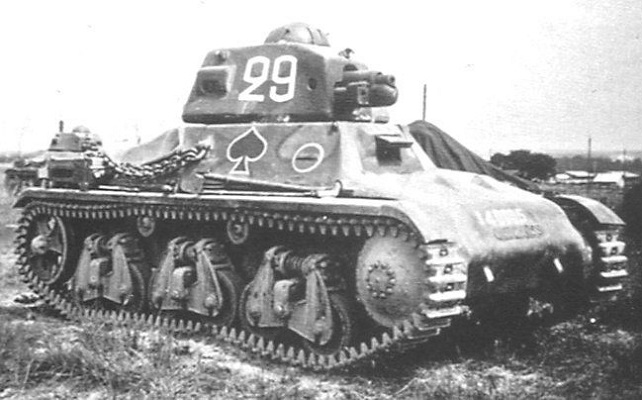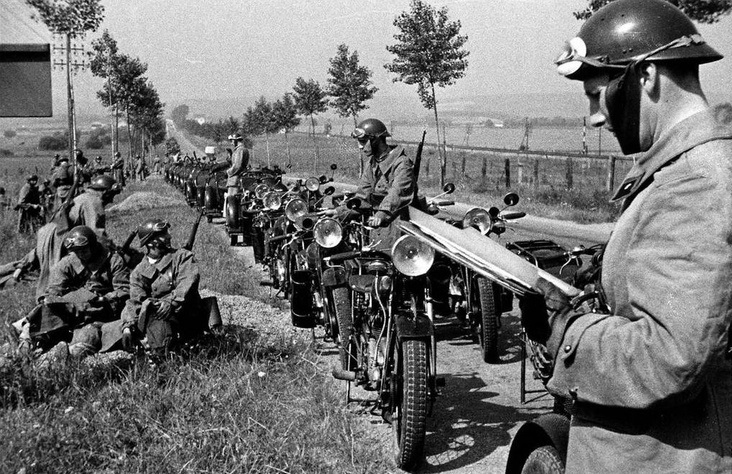Digesting the lessons of the First
World War, the French Army concluded—with some reluctance
and many caveats—that the days of horse cavalry were
numbered. In 1931, therefore, the long process of
mechanization of the cavalry began. The 4th Cavalry Division
was selected for conversion and in 1935 the divisional
elements that had so far been mechanized received a separate
identity as the 1st Light Mechanized Division (1er
Division Légères Mécanique or
1st DLM). At the
beginning of the war there were two DLMs in the Army’s order
of battle, with one more in process of formation.
The designation light for
these divisions was something of a misnomer, denoting their
ability to deploy rapidly rather than their size or
equipment. In fact they were comparable to the German Army’s
panzer division.
The DLM embodied two brigades: one armored with two tank
regiments and one mechanized with an armored reconnaissance
regiment and a motorized infantry regiment. All regiments
bore a cavalry identity, e.g. the infantry were dragons
portés (motorized dragoons). The motorized artillery
regiment had two battalions with 24 x 75mm field guns and
one battalion with 12 x 105mm howitzers, plus a motorized
antitank battery with 8 x 47mm AT guns and an antiaircraft
battery with 6 x 25mm antiaircraft guns. There were also the
usual divisional service units, all motorized: engineer,
signal, transportation, supply and medical.
It had been intended to equip the
regiments of the armored brigade with the SOUMA S-35 medium
tank: an excellent design with good armor, armed with a
high-velocity 47mm gun. But production bottlenecks made this
impossible, and so each regiment had two squadrons equipped
with the S-35 and two with the Hotchkiss H-35 infantry tank.
The latter had good armor but its short-barreled,
low-velocity 37mm gun was of limited effectiveness in the
antitank role. Accordingly an improved design, designated
H-39, entered production in 1939. It was armed with a new
high-velocity 37mm gun, which was also retrofitted to many
H-35s. By May 1940 the 1st and 2nd DLMs each had 48 x S-35
tanks and 47 x H-35 tanks—some of the latter retrofitted
with the high-velocity 37mm gun. The 3rd DLM, which began
forming in February 1940 received the H-39 in place of the
H-35.

The Hotchkiss H-35 cavalry
tank, armed with the original short-barreled 37mm gun
(Photo:
Musée de l'Armée)
The reconnaissance regiment of the
mechanized brigade was equipped with 48 x Panhard 178
armored cars armed with a 25mm gun. It was organized in two
groups, each with one squadron of armored cars and one of
motorcycle infantry. The motorized dragoon regiment had
three battalions, each with an armored reconnaissance
squadron, two motorized infantry squadrons, a motorcycle infantry squadron, and a motorized heavy weapons squadron.
The armored reconnaissance squadron was equipped with
machine gun-armed AMR35 light tanks, scheduled to be
replaced by H-39 tanks when available. (The reconnaissance regiment of the
3rd DLM received the H-39 in place of the AMR35.)
The DLM, therefore, had 95 x
gun-armed medium tanks, 69 x machine gun-armed light tanks
(164 x gun-armed tanks for the 3rd DLM) and 46 x gun-armed
armored cars. By way of comparison the German 7th Panzer
Division had 34 x Panzer I (machine guns) 68 x Panzer II
(20mm gun), 91 x Panzer 38(t) (former Czech tank; 37mm gun)
and 24 x Panzer IV (75mm gun)—and this was one of the
better-equipped panzer divisions. Though the DLM had fewer
gun-armed tanks, they were superior to the Panzer I and
Panzer II, and the S-35 was superior to all of the German
tanks except the Panzer IV. Even the DLMs’ armored cars with
their 25mm gun could destroy the Panzer I and Panzer II.
As for artillery, the panzer
divisions had a slight advantage over the DLM: All of the
former had 24 x 105mm howitzers and some also had 12 x 155mm
howitzers. On the other hand the DLM’s motorized dragoon
brigade was stronger than the panzer divisions’ motorized
infantry regiment.
The principal weak spot of the DLMs
was a lack of radios for their tanks. Though squadron
and company commanders had radio- equipped tanks for communication
with higher headquarters, company and platoon commanders
had to pass their orders by flag or hand signals. But every
German tank was radio equipped, and this gave the panzers a
decided advantage in a fast-moving engagement. Plans to
equip all tanks of the DLMs with radios had been drawn up,
but this program had barely gotten underway by May 1940.
Moreover, the smaller crew size of the
S-35—commander/gunner, loader/radio operator and driver—was
less efficient than the four- or five-man crews of German
medium tanks.

Motorcycle troops of a
motorized dragoon battalion
(Photo:
Musée de l'Armée)
More serious was the French Army’s
lack of a unified tactical/operational doctrine for the
employment of armor. Unlike the German Army, in which all
tanks belonged to a single arm of service—the Panzerwaffe—the
French Army made a distinction between “cavalry” tanks
(embodied in the DLM and the Division Légère de Cavalerie
or light cavalry division) and “infantry” tanks
(embodied in the Division Cuirassée or armored
division and the Groupe de Bataillons de Chars or
independent tank group). The two formations were differently
organized and equipped, and had different missions. The DC
was conceived as a breakthrough force, its heavy tanks
supporting the infantry in the attack, while the DLM was
conceived as a mobile exploitation force. The DLM and the DC
were not intended to operate together and could not easily
have done so, given their quite distinct characteristics.
The 1st and 2nd DLMs, which had
been raised before the war, were well-trained regular units.
The 3rd DLM, raised in early 1940 with mobilized reservists,
was not so well trained but on the other hand it received
the latest equipment. In the 1940 campaign the light
mechanized divisions served in the First Army Group,
fighting in Belgium and giving the good account of
themselves. They proved to be a match for the panzers in a
stand-up fight, and in retrospect it seems clear that the
French Army made a great mistake by not providing itself with
more of them. All three of these fine divisions were lost in the debacle suffered by
the Allied armies in May. A number of DLMs were
reconstituted and fought in the second stage of the
campaign, but none exceeded the strength of a brigade.